Low Light Imaging Market Size
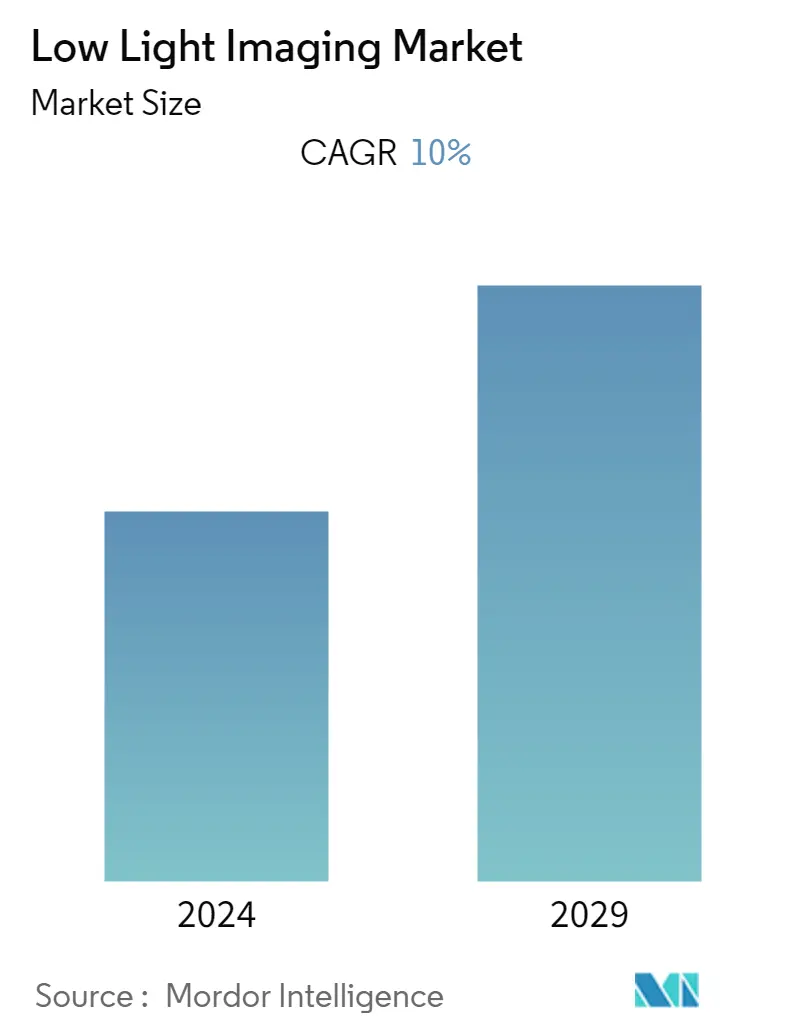
| Study Period | 2019 - 2029 |
| Base Year For Estimation | 2023 |
| CAGR | 10.00 % |
| Fastest Growing Market | Asia Pacific |
| Largest Market | Asia Pacific |
| Market Concentration | Low |
Major Players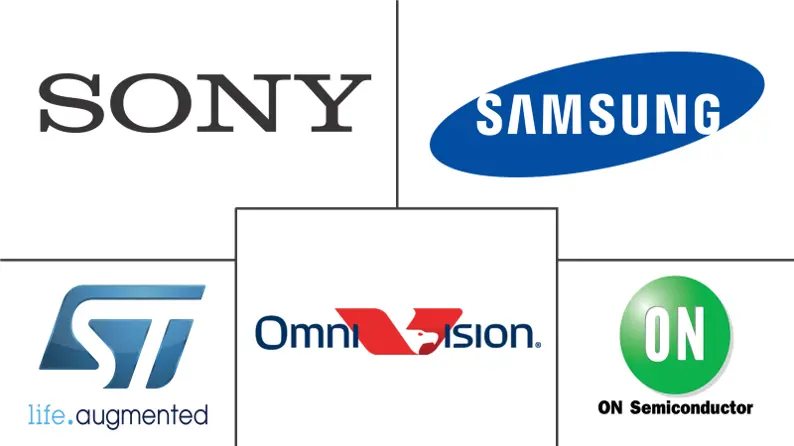
*Disclaimer: Major Players sorted in no particular order |
Low Light Imaging Market Analysis
The Low Light Imaging Market is expected to register a CAGR of 10%, over the forecast period 2021-2026. Low-light imaging is a technology used to improve the visibility of the image in dimly lit environments. The advancements in low-light technology have significantly improved sensitivity in the IP cameras and enabling capabilities to capture color images in as little as 0.1 lux illuminance.
- The industry-wide shift from CCD to CMOS sensors, which are not only less expensive to manufacture, but also offer a more flexible approach in how pixels are read and processed, enable the industry to be able to do more. It's created an enormous trajectory path leading to low light imaging solutions.
- The industry also witnessed improvements in chipsets even have gone a long way toward providing additional processing power to run more complicated algorithms for low-light image processing to render more activity and better adjust to scenes. The ability to reproduce low-light images in a highly specific color has been a critical factor in driving the continued improvement and evolution of low-light cameras.
- In the low-light scenarios, the combination of a large low-light sensor, large-aperture lenses, and proper backlighting or IR illumination is required for optimum performance. In the future, AI technology is expected to make significant improvements to low-light technology, further enhancing the image captured by the camera.
- In November 2019, the Sony A7R IV I sensor achieved an overall DXOMARK score of 99, and it especially stood out for its low light ISO and dynamic range score. Even with an increase in the density of pixels for a full-frame sensor, the sensor still performs tremendously well in the Low-Light ISO score.
- With the outbreak of COVID-19, drones are becoming vital tools in the fight against the pandemic across states with law enforcement agencies using them to monitor public gatherings, ensuring social distancing, spraying disinfectants over locations, among others. Most of the drones are equipped with larger CMOS image sensors, which makes it easier to capture high-quality images in low light.
Low Light Imaging Market Trends
This section covers the major market trends shaping the Low Light Imaging Market according to our research experts:
The growth usage of low light image photography in the smartphones
- The cameras used in the smartphones of late requires higher frame rates, higher resolution, and more extended range even in dim lit conditions, and this creates a demand for low light imaging solutions in the market. The vendors are constantly upgrading the sensors to meet the requirement of the end-users who expect better imaging solutions year on year.
- Over several generations, the low-light capabilities of smartphone cameras have increased dramatically due to the advances in sensor design, faster lenses, and computational imaging methods, current high-end phones can achieve more than acceptable results in low-light conditions. In September 2019, to reflect and evaluate the technological advancements, DXOMARK added a Night score to the smartphone camera test protocol.
- In October 2019, Google launched its Pixel 4 smartphone, whose primary camera is built around a 1/2.55-inch sensor with 12.2 MP resolution, and the camera's unique ability is to capture the night sky in stunning detail complete with stars. Astrophotography is a form of low light photography which requires highly sensitive imaging sensors to capture them efficiently.
- In 2020, various manufacturers such as Nokia and Xiaomi are trying to incorporate under-display front cameras in their smartphones to maximize to the screen to body ratio of the smartphones. Since the camera is placed under the screen, it's not receiving enough light for high-quality captures due to which companies are developing the low light image sensors to overcome the issue, and the under-display cameras are expected to commercially launch at the end of 2020 or in the beginning of 2021.
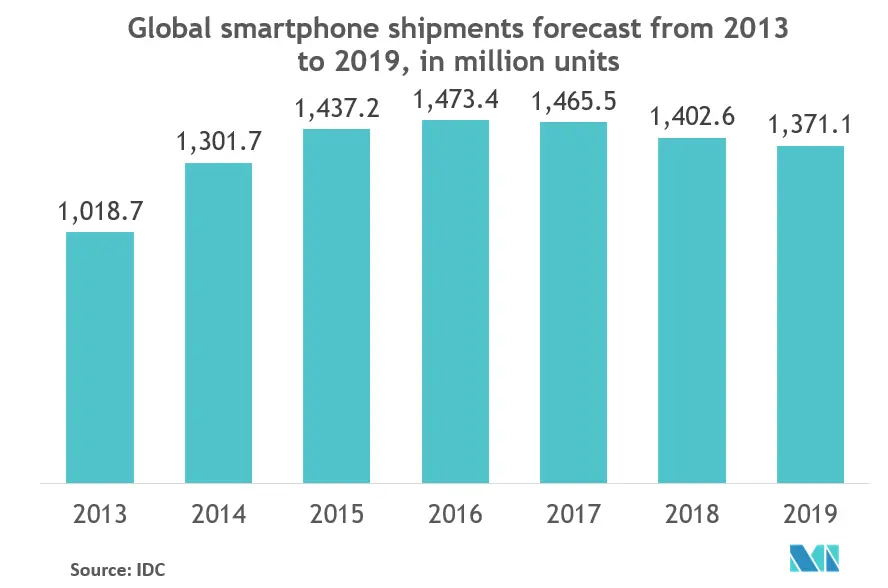
Asia Pacific is expected to witness highest growth rate
- The Asia Pacific is expected to witness the highest growth rate in the low-light imaging market during the forecast period due to the high demand for low-light imaging solutions for various automotive and electronics manufacturing companies that are located in the region which includes several manufacturing units smartphone companies who incorporate the low light image sensors.
- The region is even home for some of the major players in the low light imaging market which includes Sony Corporation, Samsung Electronics Co Ltd, Pansonic Corporation that hold significant market share compared to other players in the market and all these companies invest considerable research and developments expenditures to bring innovation in the low light imaging market.
- India's contribution to global smartphone production had jumped to 16 percent in 2019 from 9 percent in 2016. However, due to the outbreak of COVID-19 India could back to the 9 percent level in 2020 as factories have halted manufacturing activities due to the lockdown and demand is likely to stay weak till May-June which would eventually even reduce the demand for low light imaging sensors incorporated in the smartphones in the region.
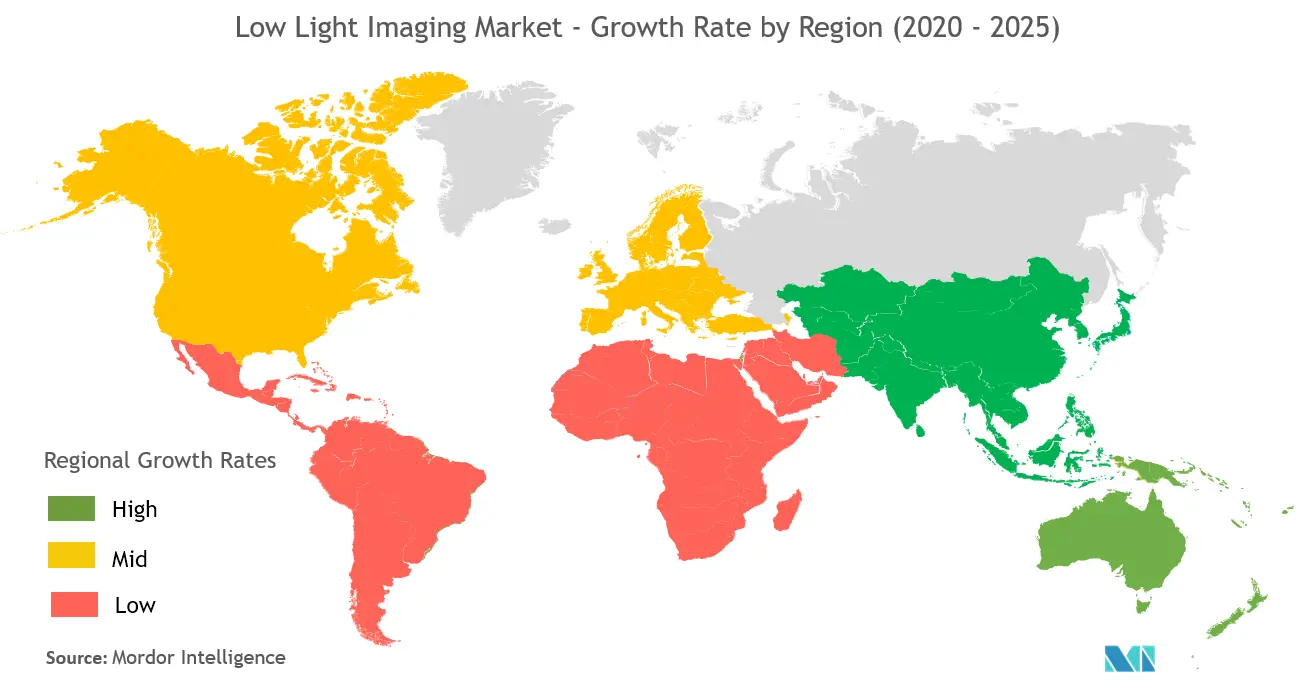
Low Light Imaging Industry Overview
The low light imaging market is fragmented due to the presence of many international players. Sony Corporation, Samsung Electronics Co Ltd, and OmniVision Technologies, Inc. some of the major players operating in the low light imaging market. Most of these players constantly innovate and develop technologically advanced low light imaging solutions and systems, to maintain their position in the worldwide market.
- June 2019 - Sony Corporation released two new models of CMOS image sensors which are the IMX415 type 1/2.8 4K-resolution stacked CMOS image sensor, which is one of the smallest in the world and the IMX485 type 1/1.2 4K-resolution back-illuminated CMOS image sensor, which delivers low-light performance approximately 3.3 times that of conventional.
- June 2019 - OmniVision Technologies, Inc., launched the OS04A10, a 2.9-micron pixel image sensor equipped with 4 megapixels resolution, which comes under the range of Nyxel near-infrared and ultra-low light sensors. The OS04A10 is designed to provide security cameras with a more excellent zoom range and AI-enabled surveillance systems with better object identification and better accuracy in terms of facial recognition.
Low Light Imaging Market Leaders
-
Sony Corporation
-
Samsung Electronics Co Ltd
-
OmniVision Technologies, Inc.
-
ON Semiconductor Corp
-
STMicroelectronics Inc
*Disclaimer: Major Players sorted in no particular order
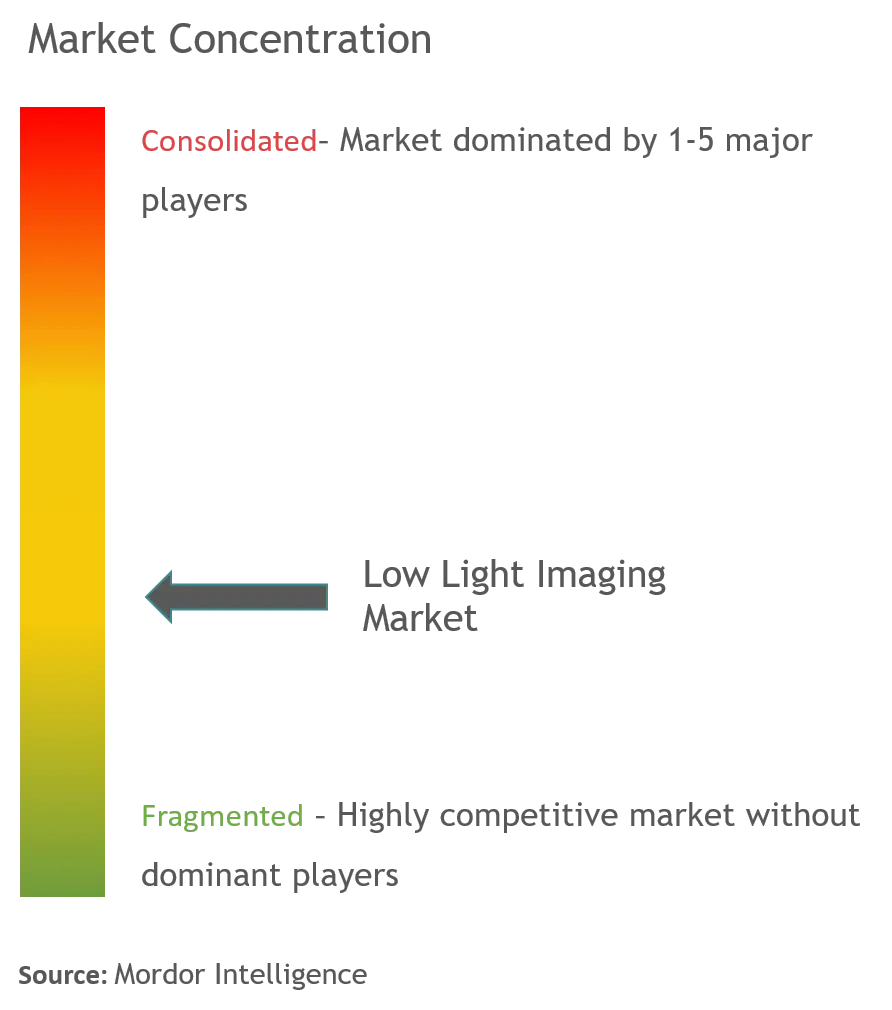
Low Light Imaging Market Report - Table of Contents
1. INTRODUCTION
- 1.1 Study Deliverables
- 1.2 Study Assumptions
- 1.3 Scope of the Study
2. RESEARCH METHODOLOGY
3. EXECUTIVE SUMMARY
4. MARKET DYNAMICS
- 4.1 Market Overview
-
4.2 Market Drivers
- 4.2.1 Increased usage of Low Light Photography in Smartphones
- 4.2.2 Enhancements in the sensor technologies and processing power
- 4.2.3 Deployment of Artificial Intelligence in the low light imaging solutions
-
4.3 Market Restraints
- 4.3.1 Outbreak of COVID-19 is expected disrupt the manufacturing sector
- 4.4 Supply Chain Analysis
-
4.5 Industry Attractiveness - Porter's Five Forces Analysis
- 4.5.1 Threat of New Entrants
- 4.5.2 Bargaining Power of Buyers/Consumers
- 4.5.3 Bargaining Power of Suppliers
- 4.5.4 Threat of Substitute Products
- 4.5.5 Intensity of Competitive Rivalry
5. MARKET SEGMENTATION
-
5.1 Type of Image Sensor
- 5.1.1 Charge-Coupled Device (CCD)
- 5.1.2 CMOS sensor (Active-Pixel Sensor)
-
5.2 Application
- 5.2.1 Scientific Imaging
- 5.2.2 Medical Imaging
- 5.2.3 Security and Surveillance
- 5.2.4 Space Imaging
- 5.2.5 Low Light Photography
- 5.2.6 Others
-
5.3 End-user Industry
- 5.3.1 Electronics
- 5.3.2 Automotive
- 5.3.3 Military and Defense
- 5.3.4 Other End-user Industries
-
5.4 Geography
- 5.4.1 North America
- 5.4.1.1 United States
- 5.4.1.2 Canada
- 5.4.2 Europe
- 5.4.2.1 Germany
- 5.4.2.2 United Kingdom
- 5.4.2.3 France
- 5.4.2.4 Rest of Europe
- 5.4.3 Asia-Pacific
- 5.4.3.1 India
- 5.4.3.2 China
- 5.4.3.3 Japan
- 5.4.3.4 Rest of Asia-Pacific
- 5.4.4 Latin America
- 5.4.4.1 Brazil
- 5.4.4.2 Argentina
- 5.4.4.3 Rest of Latin America
- 5.4.5 Middle East and Africa
- 5.4.5.1 United Arab Emirates
- 5.4.5.2 Saudi Arabia
- 5.4.5.3 Rest of Middle East and Africa
6. COMPETITIVE LANDSCAPE
-
6.1 Company Profiles
- 6.1.1 Sony Corporation
- 6.1.2 Samsung Electronics Co Ltd
- 6.1.3 Panasonic Corporation
- 6.1.4 ON Semiconductor Corp
- 6.1.5 STMicroelectronics Inc
- 6.1.6 OmniVision Technologies, Inc.
- 6.1.7 Horiba, Ltd.
- 6.1.8 Photonis Technologies S.A.S.
- 6.1.9 Oxford Instruments (Andor)
- 6.1.10 Teledyne Technologies Inc.
- *List Not Exhaustive
7. MARKET OPPORTUNITIES AND FUTURE TRENDS
** Subject To AvailablityLow Light Imaging Industry Segmentation
The low light imaging sensors generally incorporate two types of technologies which are CMOS and CCD. Low light imaging solutions are used in various applications such as low light photography, scientific imaging, medical imaging, space imaging, security and surveillance and are even used in various end-user verticals which include electronics, automotive, military and defense.
| Type of Image Sensor | Charge-Coupled Device (CCD) | |
| CMOS sensor (Active-Pixel Sensor) | ||
| Application | Scientific Imaging | |
| Medical Imaging | ||
| Security and Surveillance | ||
| Space Imaging | ||
| Low Light Photography | ||
| Others | ||
| End-user Industry | Electronics | |
| Automotive | ||
| Military and Defense | ||
| Other End-user Industries | ||
| Geography | North America | United States |
| Canada | ||
| Geography | Europe | Germany |
| United Kingdom | ||
| France | ||
| Rest of Europe | ||
| Geography | Asia-Pacific | India |
| China | ||
| Japan | ||
| Rest of Asia-Pacific | ||
| Geography | Latin America | Brazil |
| Argentina | ||
| Rest of Latin America | ||
| Geography | Middle East and Africa | United Arab Emirates |
| Saudi Arabia | ||
| Rest of Middle East and Africa |
Low Light Imaging Market Research FAQs
What is the current Low Light Imaging Market size?
The Low Light Imaging Market is projected to register a CAGR of 10% during the forecast period (2024-2029)
Who are the key players in Low Light Imaging Market?
Sony Corporation, Samsung Electronics Co Ltd, OmniVision Technologies, Inc., ON Semiconductor Corp and STMicroelectronics Inc are the major companies operating in the Low Light Imaging Market.
Which is the fastest growing region in Low Light Imaging Market?
Asia Pacific is estimated to grow at the highest CAGR over the forecast period (2024-2029).
Which region has the biggest share in Low Light Imaging Market?
In 2024, the Asia Pacific accounts for the largest market share in Low Light Imaging Market.
What years does this Low Light Imaging Market cover?
The report covers the Low Light Imaging Market historical market size for years: 2019, 2020, 2021, 2022 and 2023. The report also forecasts the Low Light Imaging Market size for years: 2024, 2025, 2026, 2027, 2028 and 2029.
Low Light Imaging Industry Report
Statistics for the 2024 Low Light Imaging market share, size and revenue growth rate, created by Mordor Intelligence™ Industry Reports. Low Light Imaging analysis includes a market forecast outlook to 2029 and historical overview. Get a sample of this industry analysis as a free report PDF download.



